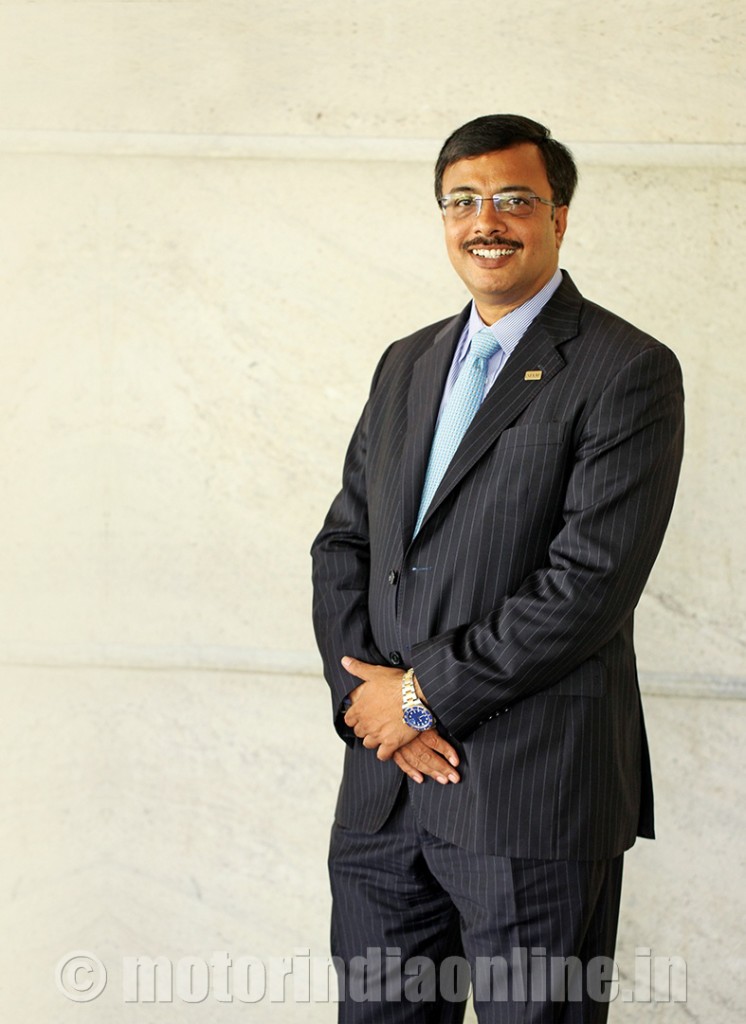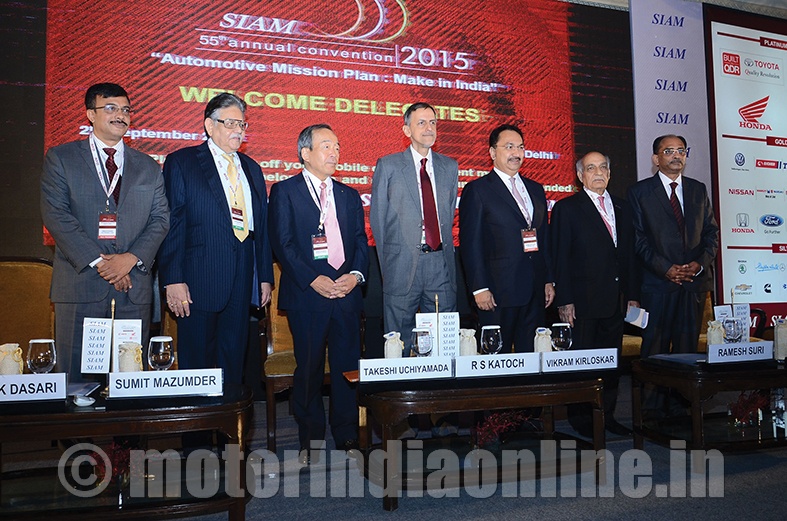
The 55th Annual Convention of the Society of Indian Automobile Manufacturers (SIAM) held in New Delhi on September 2 brought together the biggest names in the Indian auto industry once again, particularly with the presence of Union Ministers that upped the confidence level of the gathering. Themed “Automotive Mission Plan: Make in India”, the Convention had participation by several senior bureaucrats and auto industry stalwarts, including CEOs and senior representatives from the Indian and global manufacturers, who presented their perspectives about the auto industry‘s role in emerging India and the future of mobility in the country.
The session had its fitting finale with a curtain-raiser to the Automotive Mission Plan 2016-2026 (AMP 2026) which spelt out the industry targets to be achieved in the next 10 years.
Addressing the convention, Mr. Nitin Gadkari, Union Minister of Road Transport and Highways, the Chief Guest on the convention, said the Government has been mulling the option of creating a new department of transport which will be headed by a new Secretary. The new department with technically qualified experts would be set up once PMO approves of it.
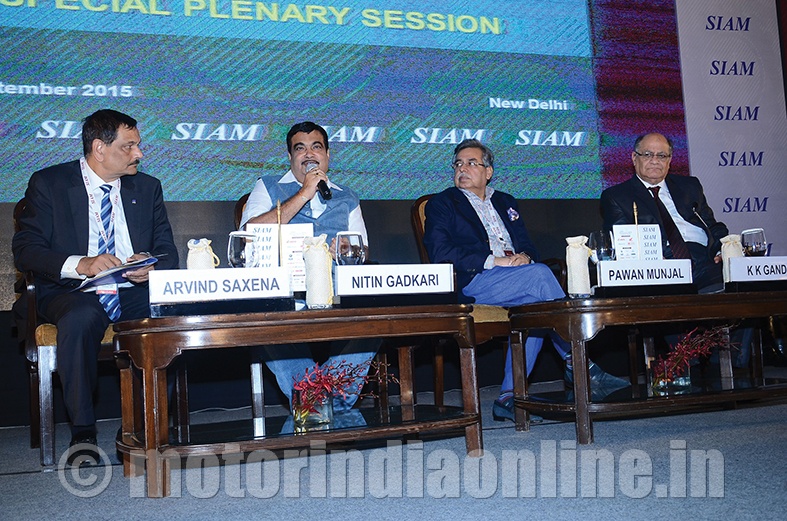
The Minister also stressed the importance of infrastructure and road safety, and stated that the Government has already ordered for nine PPP projects, which highlights the steady flow of investments in the road infrastructure. Infrastructure was the first step to improve and increase road network. However Government would also be promoting the waterways and railway network as the primary mode of transport within the country.
In his address, Mr. Amitabh Kant, Secretary, Department of Industrial Policy and Promotion, Ministry of Commerce and Industry, said: “If India has to grow at the rate of 7-8%, then the automotive and auto component industry have to be the key driver of this growth, not only in the case of manufacturing but also innovation and frugal engineering.
He also emphasised the importance of connected cars and shared mobility like services of Ola and Uber which are driven by technology.
 Welcoming the guests at the inaugural session of the convention, Mr. Vikram Kirloskar, SIAM President, and Vice Chairman, Toyota Kirloskar Motor Pvt. Ltd., said: “The last three years have been challenging for the Indian automotive industry. However, conditions have improved significantly over the past fiscal.”
Welcoming the guests at the inaugural session of the convention, Mr. Vikram Kirloskar, SIAM President, and Vice Chairman, Toyota Kirloskar Motor Pvt. Ltd., said: “The last three years have been challenging for the Indian automotive industry. However, conditions have improved significantly over the past fiscal.”
He added that the auto industry is a highly taxed sector and is unfairly targeted for being the primary cause of pollution, which the Government needs to look into. The industry is also hopeful that GST will be implemented soon.
Following Mr. Kirloskar’s speech, Mr. Ramesh Suri, President, ACMA and Chairman, Subros Ltd., and Mr. Sumit Mazumder, CII President, and Chairman & MD, TIL Ltd., also addressed the audience. Mr. Takeshi Uchiyamada, Chairman of the Board of Directors, Toyota Motor Corporation, spoke on the hybrid technology and how Toyota Prius was driving the category.
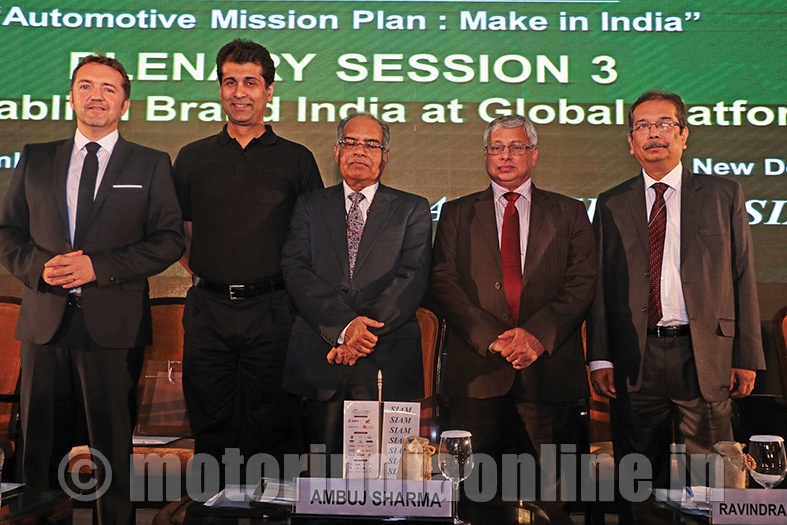
In his address, Mr. R.S. Katoch, Secretary, Ministry of Heavy industries and Public Enterprises, who was the chief guest on the occasion, said: “We have been trying to support the industry and to devise policies which would help the industry. While there have been high-level concerns on emission norms of late, we have tried to put forth the case of the industry in the best possible way with the Ministry. There are a lot of misconceptions which we believe can be addressed with proper studies on the subject matter.”
The special plenary session was inaugurated by Mr. Pawan Munjal, Chairman, CEO and MD, Hero MotoCorp Ltd. Mr. Arvind Saxena, President and MD, General Motors India, delivered the closing remarks for the session.
In the first technical session of the day, the speakers discussed the future of mobility by 2030. The discussion covered different aspects of mobility, including sustainability and hybrid technology.
Vision 3/12/65
The occasion also witnessed the curtain-raiser for the Automotive Mission Plan 2016-2026 (AMP 2026). With its ‘Vision 3/12/65’, this is the second edition of the Automotive Mission Plan after the first one in 2006-2016. The AMP 2026 is the collective vision of the Government and the Indian automotive industry, aimed at mapping the progress of the automobile industry in India and setting targets and goals for this sector over the next ten years. It addresses areas of relevance, including growth in terms of size, contribution to India’s development, global environmental footprint, technological maturity, safety, competitiveness, and institutional structure and capabilities.
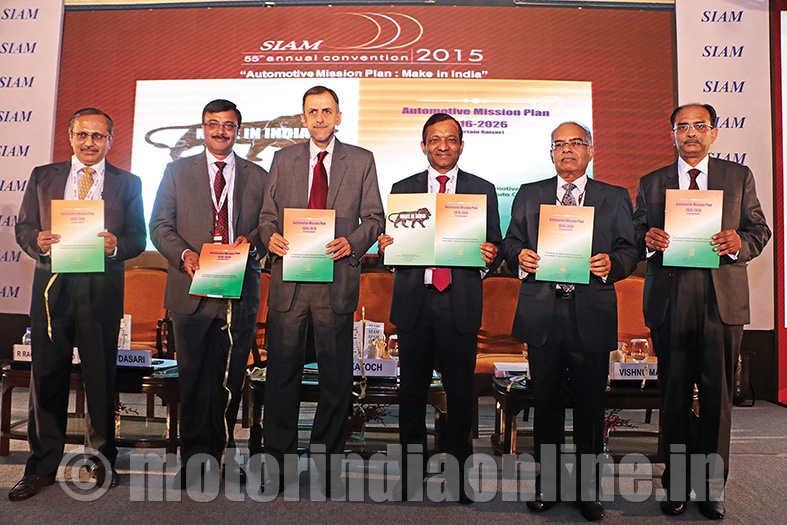
The document was unveiled at the final session of the convention, which was chaired by Dr. Pawan Goenka, Past President, SIAM, and Executive Director & Group President – Auto & Farm Sector, Mahindra & Mahindra Ltd.
Mr R. Raghuttama Rao, Managing Director, ICRA Management Consulting Services (IMaCS) presented the vision to the gathering. Talking about the key achievements of the AMP 2006-2016, he said: “The investments under AMP 2016 exceeded Rs. 1,60,000 crores and the industry is poised to generate more than 35 million jobs by the end of 2016. The industry is on course, as per the AMP 2016, to hit the base-case target of Rs. 5,49,000 crores of revenue by the end of FY16. There is also need for greater institutional co-ordination.
Outlining the vision of AMP 2026, he said: “By 2026 the Indian automotive industry will be among the top three of the world in engineering, manufacture, and export of vehicles and components, and will encompass safe, efficient and environment friendly conditions for affordable mobility of people and transportation of goods in India comparable with global standards, growing in value to over 12% of India’s GDP and generating an additional 65 million jobs.”
A quick decoding of the Vision 3/12/65 indicates that the 3 refers to India becoming one among the top three auto markets globally, 12 pointing to a minimum contribution of 12 per cent to the country’s GDP by the auto sector, and 65 indicating the additional 65 million jobs the industry hoeps to create in the country as part of the ten-year plan.
Dr. R.S. Katoch, Secretary, Department of Heavy Industry, Ministry of Heavy Industries and Public Enterprises, said that implementation of GST is a must for the industry and that the scope of growth for the industry would increase manifold if the tax structure is improved.
Implemented in 2006, the first Automotive Mission Plan (AMP 2006-2016) has till date witnessed several progressions of evolution of the Indian automobile industry with many of its objectives being met while others being fulfilled by the end of the stipulated period.
Overall, the SIAM Convention proved a much-needed platform, as it does every year, to discuss the way forward for the country’s auto sector, the potential of which has been talked about time and again and is currently in the process of being tapped in a big way. Hoping that the announcements made by the government would attain fruition, the Indian auto industry would certainly be what it has to be – a game-changer and world leader.
Vinod Dasari is new SIAM President
Mr. Vinod Dasari, Managing Director, Ashok Leyland Ltd., has been elected President of the Society of Indian Automobile Manufacturers (SIAM), the apex industry body representing leading vehicle and vehicular engine manufacturers in India. Mr. Arvind Saxena, President and Managing Director, General Motors India, and Mr. Kenichi Ayukawa, Managing Director & CEO, Maruti Suzuki India, have been elected Vice-President and Treasurer of the Association respectively.
Currently the President of the Automotive Research Association of India (ARAI), Mr. Dasari joined Ashok Leyland in 2005 as Chief Operating Officer and was appointed Whole Time Director in 2008.
Mr. Dasari commenced his career with General Electric Company in 1986. After completing his MBA in 1992, he joined Timken Company of the US in 1996, and moved to Timken’s Indian operations as Director of Manufacturing and Technology. In 1998, he was appointed Managing Director of Timken India, and in 2000 he moved back to the US as President of Timken’s Global Railroad business. In 2002, he joined Cummins India Ltd. as President.
Mr. Dasari completed his MBA from Kellogg School of Management and a Masters in Engineering Management from McCormick School of Engineering, both from Northwestern University. He earned a Bachelor’s Degree in Engineering from the University of Louisville.

